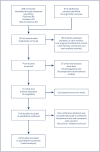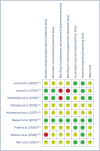A meta-analysis of ferric carboxymaltose versus other intravenous iron preparations for the management of iron deficiency anemia during pregnancy
- PMID: 38765534
- PMCID: PMC11075392
- DOI: 10.61622/rbgo/2024AO21
A meta-analysis of ferric carboxymaltose versus other intravenous iron preparations for the management of iron deficiency anemia during pregnancy
Abstract
Objective: We conducted a meta-analysis of randomized clinical trials evaluating the clinical effects of ferric carboxymaltose therapy compared to other intravenous iron in improving hemoglobin and serum ferritin in pregnant women. We also assessed the safety of ferric carboxymaltose vs. other intravenous iron.
Data source: EMBASE, PubMed, and Web of Science were searched for trials related to ferric carboxymaltose in pregnant women, published between 2005 and 2021. We also reviewed articles from google scholar. The keywords "ferric carboxymaltose," "FCM," "intravenous," "randomized," "pregnancy," "quality of life," and "neonatal outcomes" were used to search the literature. The search was limited to pregnant women.
Selection of studies: Studies related to ferric carboxymaltose in pregnancy were scanned. Observational studies, review articles, and case reports were excluded. Randomized studies in pregnant women involving ferric carboxymaltose and other intravenous iron formulations were shortlisted. Of 256 studies, nine randomized control trials were selected.
Data collection: Two reviewers independently extracted data from nine selected trials.
Data synthesis: The final effect size for increase in hemoglobin after treatment was significant for ferric carboxymaltose vs. iron sucrose/iron polymaltose (standard mean difference 0.89g/dl [95% confidence interval 0.27,1.51]). The final effect size for the increase in ferritin after treatment was more for ferric carboxymaltose vs. iron sucrose/iron polymaltose (standard mean difference 22.53µg/L [-7.26, 52.33]). No serious adverse events were reported with ferric carboxymaltose or other intravenous iron.
Conclusion: Ferric carboxymaltose demonstrated better efficacy than other intravenous iron in increasing hemoglobin and ferritin levels in treating iron deficiency anemia in pregnant women.
Keywords: Anemia; Ferric carboximaltose; Ferric oxide; Ferritin; Hemoglobin; Intravenous iron; Iron polymaltose; Iron sucrose; Iron-deficiency anemia; Pregnancy; saccharated.
© 2024. Federação Brasileira de Ginecologia e Obstetrícia. All rights reserved.
Conflict of interest statement
Conflicts to interest: none to declare.
Figures








References
-
- World Health Organization (WHO) Anaemia. Geneva: WHO; 2022. [cited 2022 Sep 6]. Available from: https://www.who.int/health-topics/anaemia.
-
- Stevens GA, Finucane MM, De-Regil LM, Paciorek CJ, Flaxman SR, Branca F, et al. Global, regional, and national trends in haemoglobin concentration and prevalence of total and severe anaemia in children and pregnant and non-pregnant women for 1995–2011: a systematic analysis of population-representative data. Lancet Glob Health. 2013;1(1):e16–e25. doi: 10.1016/S2214-109X(13)70001-9. - DOI - PMC - PubMed
-
- World Health Organization (WHO) The Global Health Observatory. Prevalence of anaemia in pregnant women (aged 15-49) (%) Geneva: WHO; 2019. [cited 2022 Mar 8]. Available from: https://www.who.int/data/gho/data/indicators/indicator-details/GHO/preva...
Publication types
MeSH terms
Substances
LinkOut - more resources
Full Text Sources
Research Materials
